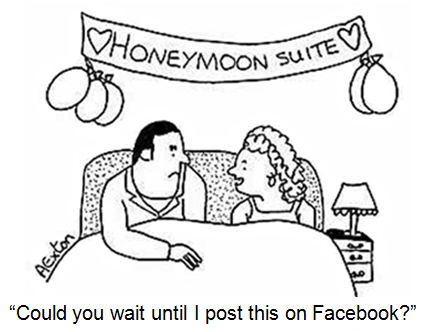 Social media is about social science not technology. As such, its value is not realized in the Likenomics of relationship status nor in the scores individuals earn by engaging in social networks. The value of social media comes down to people, relationships, and the meaningful actions between them. As such, its value is measured through the exchange of social currencies that contribute to one’s capital within each network. Through conversations, what we share, and the content we create, consume and curate, we individually invest in the commerce of information and the relationships that naturally unfold. It is in how these relationships take shape that is both in and out of your control. This is why, in the age of social networking, relevant engagement counts for everything.
Social media is about social science not technology. As such, its value is not realized in the Likenomics of relationship status nor in the scores individuals earn by engaging in social networks. The value of social media comes down to people, relationships, and the meaningful actions between them. As such, its value is measured through the exchange of social currencies that contribute to one’s capital within each network. Through conversations, what we share, and the content we create, consume and curate, we individually invest in the commerce of information and the relationships that naturally unfold. It is in how these relationships take shape that is both in and out of your control. This is why, in the age of social networking, relevant engagement counts for everything.
trust
Banking With Apple Could Pose Serious Challenge to High Street According to a New Research Report
 From PRnewswire: Leading strategic marketing and research consultancy KAE, in conjunction with Toluna, a global pioneer in online polls, surveys and opinions, this week reveal the startling findings of a new research study into the opinions of consumers towards the potential of technology giant, Apple, breaking into the banking sector.
From PRnewswire: Leading strategic marketing and research consultancy KAE, in conjunction with Toluna, a global pioneer in online polls, surveys and opinions, this week reveal the startling findings of a new research study into the opinions of consumers towards the potential of technology giant, Apple, breaking into the banking sector.
The survey, using Toluna’s global research panel community of 4 million consumers worldwide, collected data from over 5,000 respondents, across the US and UK, and revealed that one in ten people (10%) would consider banking with Apple. Of those who are already Apple customers, 43% would switch to Apple for their day to day banking needs.
Research shows Facebook emotional boost is like marriage
 Do social media technologies isolate people and promote false relationships? Or are there important benefits associated with being connected to others in this way?
Do social media technologies isolate people and promote false relationships? Or are there important benefits associated with being connected to others in this way?
The Pew Research Center’s Internet & American Life Project decided to examine these questions in a survey that explored people’s overall social networks and how use of these technologies is related to trust, tolerance, social support, and community and political engagement.
Among the many interesting findings, Pew reports that the social relationship “boost” received by Facebook users is equivalent to about half the total support that the average American receives as a result of being married.
How do you increase social influence? Don’t think about the score

Influence: The capacity to have an effect on the character, development, or behavior of someone or something, or the effect itself.
Digital influence is a controversial topic. At the heart of the matter is this idea of influence and it raises questions and doubts as to whether or not the ability to cause effect or change behavior is truly measurable. Regardless of the answer, we are introduced to a new reality of social networking, an era where our actions and words in Facebook, Twitter et al. are used for and against us.
One day we awoke to find a number attached to our digital persona. And in this new awakening is a fascinating new twist in social media, the association between scores and avatars and the new digital socioeconomic factors that are introduced. We are now ranked and what was once a peer-to-peer network is now tiered, creating a social hierarchy where a score defines your place within it.
We didn’t opt in, we can’t opt out, but we can shape it.
Welcome to the EGOsystem.
Don’t Forget to Ask Women for Direction(s)!
In this new social media marketing world — where it’s less about demographics and more about relationships — one demographic still clearly matters: WOMEN.
Women control 85% of household spending, and (according to Bank of America Merrill Lynch)
in 2011, women’s earning power will recover from the recession far quicker than men’s earning power will.
These numbers are good news for marketers, but they need to come with a strong CAUTION statement: just because women are a strong purchasing demographic does not mean we can pay any less attention to the relationship work required to make and keep our brands highly relevant to women.
The Antidote to Negative Commentary
As much as we might not want to admit it, something negative about our brand will be said sometime by someone in a social network. It might be due to a change, or something out of the brand’s control or only one little misstep in many months, but chances are, that unfortunate experience will be shared. Such is the nature of information-sharing through social networks.
But it’s that same nature of social media that also gives us a powerful antidote to negative commentary – ENGAGEMENT.
We might be tempted to cover any negative feedback with a huge push of positive messaging, stating and re-stating how wonderful our products and services really are. This attempt at damage-control, however, does little if anything to protect our brand reputation. Whether or not our products and services are usually terrific doesn’t matter to the person who had a different experience with our brand, nor to those closest in their social network. What matters to them is the one unsatisfying experience they had.
This is where engagement becomes vital. We can stay disengaged and pretend nothing negative was said, but ignoring those comments won’t keep them from spreading quickly through various social networks. If we choose instead to engage with the consumer(s) making those comments, we have a huge opportunity to help positively change the perception of our brand.
Everything you wanted to know about influence but were afraid to ask

One word that seems to be getting more attention with every new Twitter and Facebook account that’s added.
What does it mean, is it important, how do you measure it and which tools and methods best reflect this ephemeral new elixir? The Social CMO Crew has now been hard at it for just over a year generating more than 300 posts and I thought this would be a great opportunity to take a retrospective look through these focusing on this theme of influence.
In looking at all the blogs we’ve created, there are four words that resonate and help us to better frame this discussion, and these are Trust, Relationships, Social Capital and of course… Influence.
Women’s Online Communities Powerhouses of Trust
 It’s becoming more and more clear that women’s online communities are the true powerhouses of trust.
It’s becoming more and more clear that women’s online communities are the true powerhouses of trust.
Social networks have their place, but it’s the online communities that women trust the most for brand and product referrals.
New research not only backs up that claim, but hits it out of the park.
Extend your influence by extending trust: a social story
A stranger walks into your store and tells you about his problem. After asking him a few questions to help you understand the problem, you hand him a brand new pair of shoes and tell him to try them for couple weeks. “If they work,” you say, “just come back and pay for them. If they don’t, we’ll try a different pair.” Typical? Probably not.
That’s exactly what Jeff Milliman, the 1980 NCAA cross country champion, did in 1998 for Olivier Blanchard. Olivier wrote about his experience with Jeff in a 2005 blog post called That Bond of Trust. I caught up with Jeff today at his new home at Go Run, a part of Go Tri Sports, in downtown Greenville, South Carolina.
Social Story: Tell me about Olivier. A story of trust. from Trey Pennington on Vimeo.
Please note a few really cool things about this social story:
- Jeff just did what he always does: listens to people and then applies his knowledge to try to help solve their problems.
- Jeff is willing to take a risk in order to fulfill his passion.
- Jeff did the unexpected and went the extra mile and SEVEN YEARS LATER the object of his generosity, Olivier Blanchard, wrote about it. (How many shoe salesmen have people writing glowing stories about them seven years after the sale, or seven hours?)
- Jeff’s act of generosity and Olivier’s act of gratitude enabled an long lost friend to reconnect with Jeff after nearly 20 years apart.
That means you never can tell when the harvest of your generosity will come.
Little lies and small promises
“I’ll be out of bed in five minutes,” is not a true statement because it’s a promise not meant to be kept. It actually means, “go away, I’m sleeping, I’ll say what I need to get rid of you.”
“Your call is very important to us,” is not a true statement either. The truth is self-evident.
“I promise I’ll tell the manager about this,” is of course not a real promise either. It might be uttered with good intent, or might be designed to get an annoying customer to go away, but still…
You can already guess the problem with little lies. They blur the line, and they lead (pretty quickly) to big lies. The worst kind of little lies are the ones you make to yourself. Once you’re willing to lie to yourself, you’re also willing to cheat at golf, and after that, it’s all downhill.
Companies that refuse to break small promises have a much easier time keeping big promises. And they earn a reputation, one that makes their handshake worth more.
Given that expectation and trust are just about all we have left to sell, it seems to me that little lies and small promises are at the very heart of the matter. And they’re a simple choice, nothing requiring an MBA or a spreadsheet.
It all depends on what you want to stand for.
Seth Godin